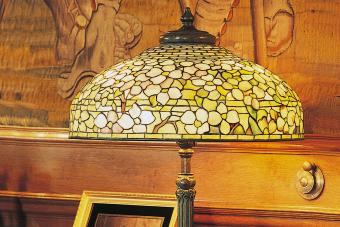
No one likes polishing silver, and knowing how to store silver properly can cut down on tarnish and reduce the time you'll spend polishing. Proper storage can also help protect your silver items from scratches and other damage that can affect the value.
What Is the Best Way to Keep Silver From Tarnishing?
Tarnish happens when silver reacts with hydrogen sulphide and other sulphide compounds in the air. This reaction causes a thin layer of silver sulphide to form on the piece, creating a black coating that reduces the beauty of the item. In addition, polishing silver actually removes a little of the metal, and too much polishing can detract from the value of silver antiques. In the case of silver plate, the polishing can actually remove the plated layer over time, revealing the less attractive base metal beneath the surface. According to the Canadian Conservation Institute, which manages museum collections, proper storage is essential to keep silver from tarnishing. There are several methods to consider, and the best one may depend on what you're storing.
How to Store Silver Flatware
Silver plated and sterling silver flatware can add a touch of beauty to your table. These heirloom pieces can last for hundreds of years if stored properly. There are a few options to consider.
Silver Cloth Wraps and Drawer Liners
You can store silver flatware in silver cloth wraps, bags, and drawer liners, which protect from scratches and inhibit tarnish. Silver cloth is specially made to include silver ions in the fabric. These react with the air before the flatware has a chance to. When all of the silver ions have been used up, the cloth is no longer effective in controlling tarnish. However, the cloth will still protect silver flatware from scratches. Prices vary depending on the complexity of the wrap or liner, but a divided silver cloth drawer liner sells for about $82 on Amazon.
Silver Flatware Chests
Another option is a silver flatware chest, available Silver flatware chests have dedicated spaces for the various pieces, reducing the chance of scratching and damage from pieces clinking into one another. Flatware storage chests are lined with silver cloth. The chest also reduces air circulation, which helps keep the silver from tarnishing. Chests come in different sizes and styles, but they often retail for between $100 and $300. A Reed and Barton 120-piece chest sells for about $170.

How to Store Silver Hollowware and Large Items
Large silver items, such as tea sets, vases, and candlesticks, can't easily be stored in chests. However, there are other options to help prevent tarnish and scratches.
Individual Silver Cloth Bags
You can buy larger silver cloth bags for items you need to store. Choose the bag size based on the size of the item, and try to store the piece in a place where it will receive minimal air circulation. You should only store one piece per bag to keep the items from clinking together and damaging one another. An 18-inch by 18-inch zippered silver cloth bag retails for about $30.
Acid-Free Tissue Paper and Sealed Plastic
You can also store silver in plastic bags. The key is to wrap the item in acid-free tissue paper first to protect it from contact with the plastic and give it added protection from scratching. Then place the item in a plastic bag and remove as much air as possible. Seal the bag for storage.
How to Store Silver Bars and Bullion
You can also use acid-free tissue paper and a sealed plastic bag for storing silver bullion or silver bars. Just wrap each bar in tissue paper and place it in the bag. You can store more than one bar in each bag if you make sure they are individually wrapped in tissue paper first.
How to Store Silver Jewelry
Storing silver jewelry is also about reducing air exposure, humidity, and acid. You can use jewelry boxes lined in silver cloth to help as well. Keep a desiccant packet in your jewelry box to dry the air.
Displaying and Storing Silver at the Same Time
You don't have to hide your silver away to store it properly. Although it is more difficult to store silver in a glass-front cabinet and keep it from getting tarnished, it is possible. It helps to choose a china cabinet that seals well to prevent air circulation as much as possible. Then add desiccant packets to the cabinet to help absorb any moisture in the air and reduce the tarnish.
Silver Storage: What Not to Do
There are some silver storage methods that are not effective or can even damage your investment. Keep the following in mind:
- Never store silver in newspaper, which contains acids that can damage it over time.
- Avoid storing silver in cellophane or plastic wrap and securing it with rubber bands. This does not provide a good seal and can cause damage.
- Don't store silver in areas where the temperature fluctuates a lot. Try to keep it as close to room temperature as possible.
- Avoid storing silver in humid places, since humidity can accelerate the tarnishing process.
- Never store silver when it is dirty or wet. Make sure to wash and dry it thoroughly first.
- Do not store silver items in cardboard boxes, which can introduce acid and offer little protection from scratching.
Good Silver Storage Practices Are Essential
If you properly store your silver pieces, you'll find you don't need to spend as much time polishing silver before you use it. This is especially important if you'll be collecting antique silver, which can be damaged by too much polishing. Good storage practices are essential for protecting the value of silver items and keeping them beautiful for generations to come.







